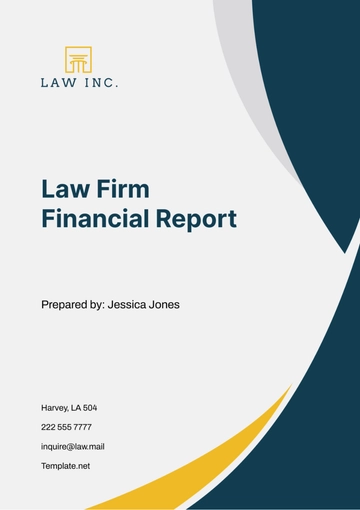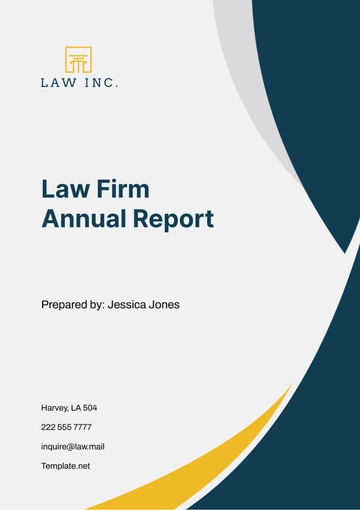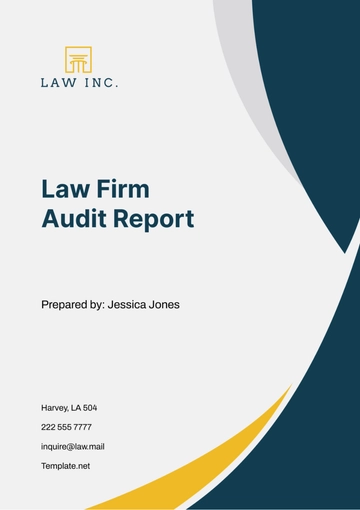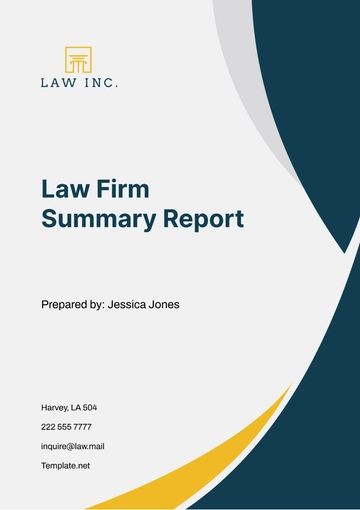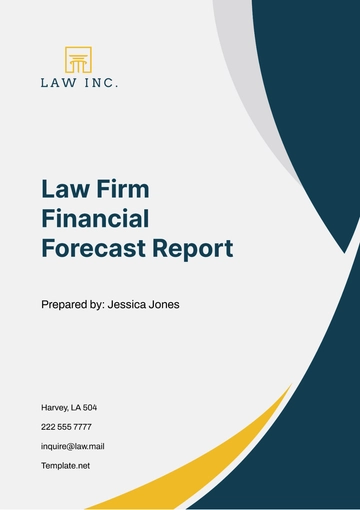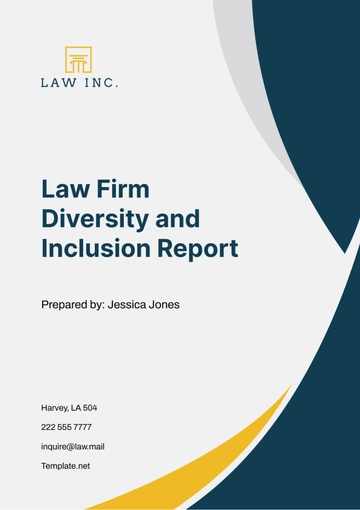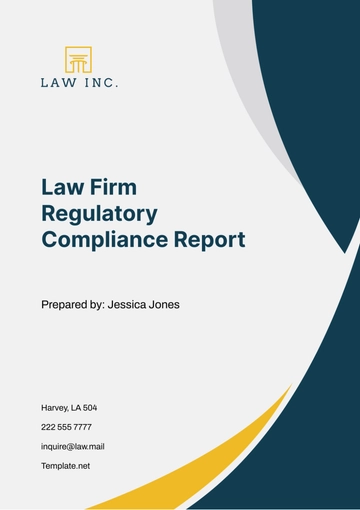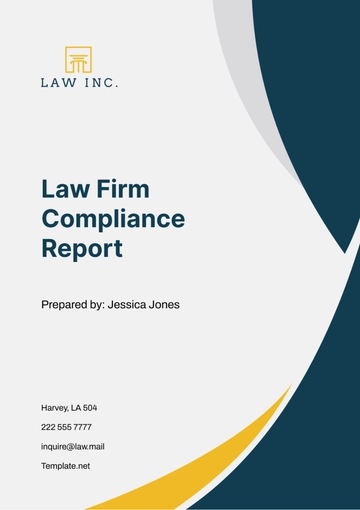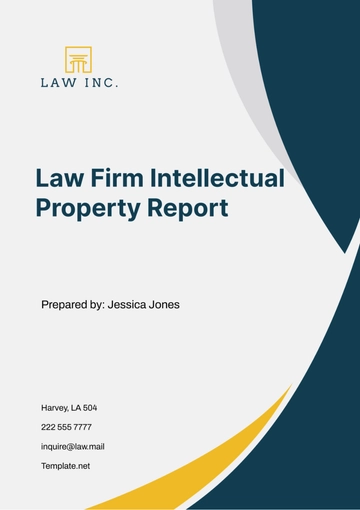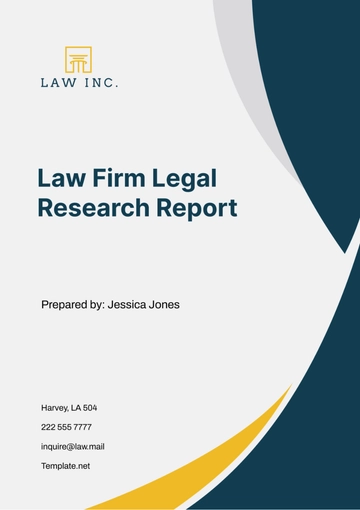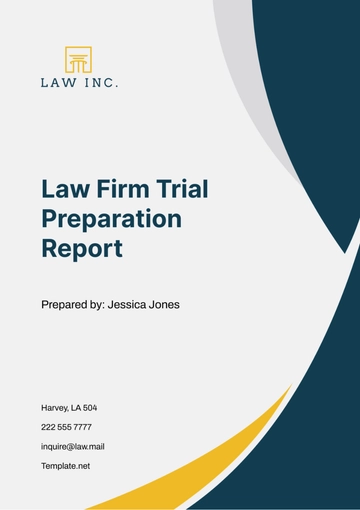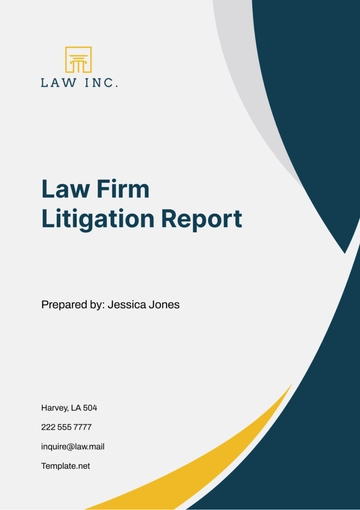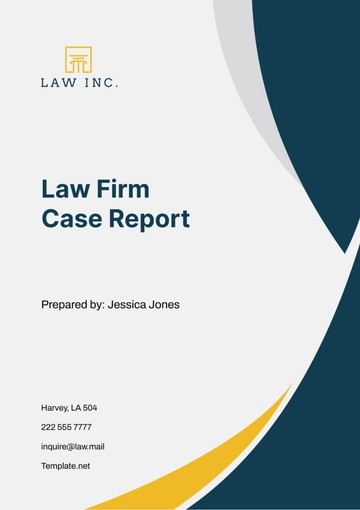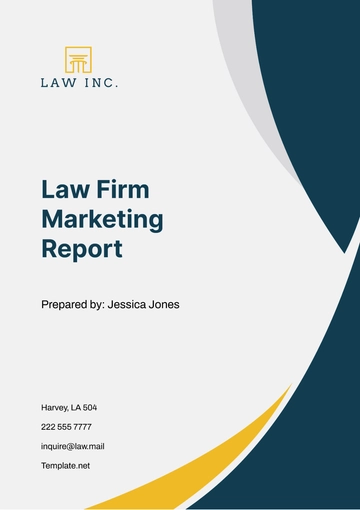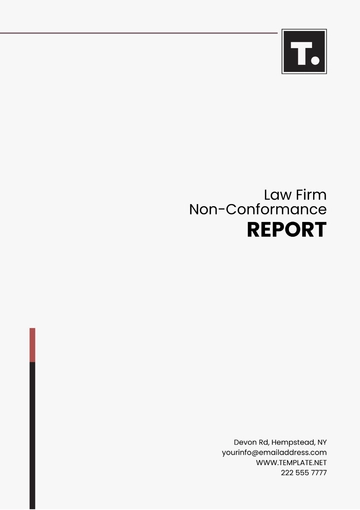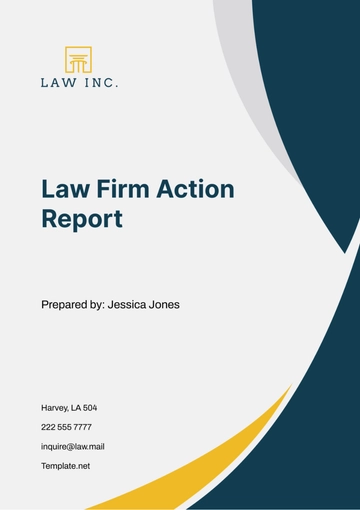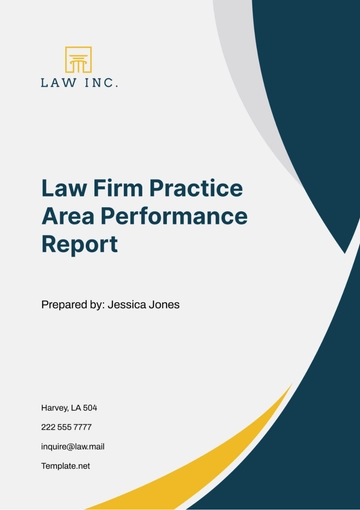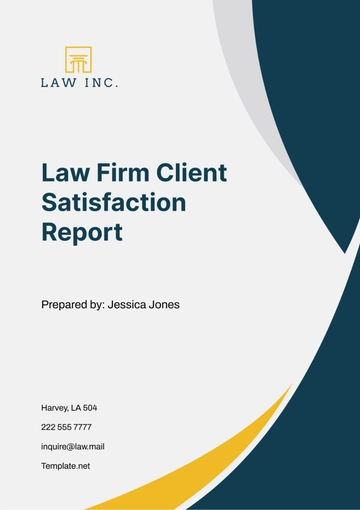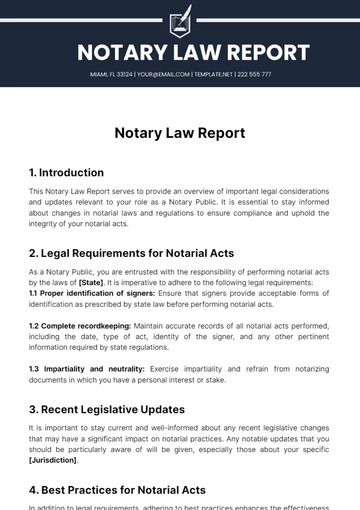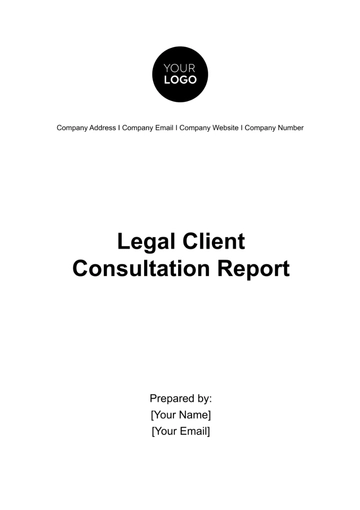Free Law Firm Financial Report

I. Executive Summary
The financial performance of [Your Company Name] for the year 2024 reflects a period of steady growth and strategic adaptation amidst evolving market dynamics. Despite facing challenges posed by external factors, the firm demonstrated resilience and agility, resulting in favorable outcomes across key financial metrics.
Throughout 2024, [Your Company Name] experienced robust revenue growth, driven by an increase in billable hours and successful resolution of contingency cases. This growth was supported by a comprehensive client-centric approach and targeted business development initiatives.
While operating expenses saw a moderate increase due to investments in technology infrastructure and talent acquisition, [Your Company Name] maintained healthy profitability margins, reflecting prudent financial management and cost control measures.
Client satisfaction remained a top priority, as evidenced by our high client retention rate and positive feedback received throughout the year. The firm's commitment to delivering exceptional legal services continues to foster long-term client relationships and drive organic growth.
Looking ahead, [Your Company Name] is poised to capitalize on emerging opportunities in the legal market, leveraging its strong foundation and client-focused approach to sustain growth and deliver value to stakeholders in the coming years.
II. Financial Performance
A. Revenue Analysis
Category | Amount ($) | % of Total Revenue |
|---|---|---|
Billable Hours | $2,500,000 | 50% |
Contingency Fees | $1,200,000 | 24% |
Retainers | $800,000 | 16% |
Other | $500,000 | 10% |
Total Revenue | $5,000,000 | 100% |
Billable Hours: Revenue generated from billable hours represents fees charged to clients for legal services provided by attorneys and legal professionals on an hourly basis. This category includes time spent on client consultations, legal research, drafting documents, court appearances, and other billable activities. Revenue from billable hours is calculated by multiplying the number of hours worked by the billing rate for each attorney or legal professional.
Contingency Fees: Contingency fees are revenue earned from legal cases where the law firm agrees to represent clients without charging upfront fees. Instead, the firm receives a percentage of the settlement or judgment awarded to the client if the case is successful. Contingency fee arrangements are common in personal injury, medical malpractice, and other types of litigation where clients may not have the financial means to pay for legal services out of pocket.
Retainers: Retainers represent upfront payments made by clients to secure the services of the law firm on an ongoing basis. Retainer agreements typically involve a fixed monthly or annual fee paid by the client in exchange for access to legal advice and representation as needed. Retainers are commonly used for corporate clients, businesses, and individuals who require regular legal assistance and support.
Other: This category includes revenue from other sources not covered by the previous categories, such as flat fees for specific legal services, commissions from referrals, income from ancillary services (e.g., document preparation, notary services), and any miscellaneous revenue streams generated by the firm's activities.
Total Revenue: The total revenue figure represents the sum of revenue generated from all sources during the reporting period and provides an overall measure of the firm's financial performance and revenue-generating activities.
B. Expense Analysis
Expense Category | Amount ($) | % of Total Expenses |
|---|---|---|
Salaries | $1,800,000 | 36% |
Rent | $300,000 | 6% |
Utilities | $100,000 | 2% |
Technology | $400,000 | 8% |
Marketing | $200,000 | 4% |
Other | $600,000 | 12% |
Total Expenses | $4,400,000 | 100% |
Salaries: Salaries represent the total compensation paid to employees of the law firm, including attorneys, paralegals, administrative staff, and support personnel. Salaries are typically the largest expense category for law firms and encompass both base salaries and additional compensation such as bonuses, commissions, and benefits (e.g., health insurance, retirement contributions).
Rent: Rent expense includes payments made for office space and facilities leased by the law firm to conduct its business operations. This category covers monthly lease payments, utilities (e.g., electricity, water, internet), property taxes, maintenance fees, and other related expenses associated with maintaining the firm's physical office space.
Utilities: Utilities expenses represent the costs associated with essential services required to operate the law firm's office, such as electricity, water, heating, cooling, internet, and telecommunications services. These expenses are necessary to maintain a functional and productive work environment for attorneys and staff.
Technology: Technology expenses encompass the costs associated with acquiring, maintaining, and upgrading the firm's technological infrastructure and software systems. This includes expenses related to computers, servers, networking equipment, software licenses, cybersecurity measures, IT support services, and other technology-related expenditures aimed at enhancing operational efficiency and supporting the firm's business activities.
Marketing: Marketing expenses cover the costs incurred by the law firm to promote its services, build brand awareness, and attract new clients. This category includes expenditures on advertising campaigns, digital marketing efforts (e.g., website development, social media advertising), print materials (e.g., brochures, business cards), sponsorships, events, and other marketing initiatives aimed at expanding the firm's client base and market presence.
Other: The "Other" category encompasses miscellaneous expenses not covered by the previous categories. This may include professional fees (e.g., accounting, legal, consulting), travel expenses, office supplies, insurance premiums, dues and subscriptions, training and development costs, and any other incidental expenses necessary for the day-to-day operation of the law firm.
Total Expenses: The total expenses figure represents the sum of all operating expenses incurred by the law firm during the reporting period. It provides insight into the firm's cost structure and expenditure patterns, helping to assess overall financial health and efficiency.
C. Profitability Analysis
Item | Value |
|---|---|
Gross Profit Margin | 12% |
Net Profit Margin | 8% |
Return on Investment (ROI) | 15% |
Gross Profit Margin: The gross profit margin is a financial metric that measures the percentage of revenue that exceeds the cost of goods sold (COGS) or, in the case of a law firm, the direct costs associated with delivering legal services. It indicates the efficiency of the firm's operations in generating revenue and covers expenses directly attributable to providing legal services, such as attorney salaries, paralegal wages, and case-related expenses. A higher gross profit margin indicates greater efficiency and profitability in delivering legal services.
Net Profit Margin: The net profit margin is a profitability ratio that measures the percentage of revenue that remains as net income after deducting all expenses, including both direct and indirect costs incurred by the law firm. It reflects the firm's overall profitability and efficiency in managing its expenses relative to its revenue. Net profit margin takes into account all operating expenses, such as salaries, rent, utilities, technology, marketing, and other overhead costs, providing a comprehensive assessment of the firm's financial performance and profitability.
Return on Investment (ROI): Return on Investment (ROI) is a financial metric that evaluates the profitability of an investment relative to its cost. In the context of a law firm, ROI can be calculated to assess the effectiveness of various investments made by the firm, such as marketing campaigns, technology upgrades, or expansion initiatives. ROI is calculated by dividing the net profit generated from the investment by the total cost of the investment and expressing the result as a percentage. A higher ROI indicates a more favorable return on the firm's investment, whereas a lower ROI suggests that the investment may not be generating sufficient returns to justify its cost.
III. Client Information
Item | Value |
|---|---|
Number of Clients Served | 150 |
Client Retention Rate | 85% |
Revenue Contribution from Top 5 Clients | $1,500,000 |
Number of Clients Served: This metric represents the total number of unique clients served by the law firm during the reporting period. It provides insight into the breadth and diversity of the firm's client base and helps assess the firm's ability to attract and retain clients across various practice areas.
Client Retention Rate: The client retention rate measures the percentage of clients who continue to engage the services of the law firm over time. It is calculated by dividing the number of clients retained by the total number of clients served and expressing the result as a percentage. A high client retention rate indicates strong client satisfaction, loyalty, and the effectiveness of the firm's client relationship management efforts.
Revenue Contribution from Top Clients: This metric highlights the revenue generated from the firm's top clients, typically the top five or ten clients that contribute the highest revenue during the reporting period. It provides insight into the importance of key client relationships to the firm's financial performance and helps identify opportunities for client diversification and revenue growth.
IV. Practice Area Performance
A. Revenue by Practice Area
Practice Area | Revenue ($) | % of Total Revenue |
|---|---|---|
Corporate Law | $1,800,000 | 36% |
Litigation | $1,200,000 | 24% |
Intellectual Property | $800,000 | 16% |
Real Estate | $600,000 | 12% |
Family Law | $600,000 | 12% |
B. Profitability by Practice Area
Practice Area | Gross Profit Margin | Net Profit Margin |
|---|---|---|
Corporate Law | 15% | 10% |
Litigation | 12% | 8% |
Intellectual Property | 10% | 6% |
Real Estate | 8% | 5% |
Family Law | 8% | 5% |
V. Budget vs. Actual Analysis
Category | Budget | Actual | Variance ($) | Variance (%) |
|---|---|---|---|---|
Salaries | $1,500,000 | $1,550,000 | -$50,000 | -3.33% |
Rent | $200,000 | $210,000 | -$10,000 | -5.00% |
Utilities | $50,000 | $55,000 | -$5,000 | -10.00% |
Technology | $150,000 | $140,000 | $10,000 | 6.67% |
Marketing | $100,000 | $90,000 | $10,000 | 10.00% |
Other Expenses | $200,000 | $220,000 | -$20,000 | -10.00% |
Total Expenses | $2,200,000 | $2,265,000 | -$65,000 | -2.95% |
Salaries: Actual salaries surpassed the budgeted amount by $50,000, reflecting a 3.33% negative variance. This overage may be attributed to higher-than-projected payroll costs, inclusive of bonuses, overtime, or additional hires during the period.
Rent: Exceeding the budgeted amount by $10,000, the actual rent expense resulted in a negative variance of 5.00%. Factors contributing to this variance might include increased rental rates, expanded office space, or unforeseen utility charges.
Utilities: Actual utility expenses surpassed the budgeted amount by $5,000, equating to a 10.00% negative variance. This discrepancy could stem from heightened energy consumption, elevated utility rates, or unexpected maintenance costs.
Technology: Despite a budgeted amount of $150,000, actual technology expenses fell $10,000 below projections, yielding a 6.67% positive variance. Possible reasons for this variance include cost-saving measures, negotiated vendor discounts, or postponed technology upgrades.
Marketing: Actual marketing expenses were $10,000 lower than budgeted, resulting in a positive variance of 10.00%. This variance may be indicative of the efficacy of cost-efficient marketing strategies or underspending on planned marketing initiatives.
Other Expenses: Exceeding the budgeted amount by $20,000, actual other expenses incurred a 10.00% negative variance. This variance could be attributed to unanticipated expenses or overspending in operational areas such as professional fees, travel, or office supplies.
Total Expenses: Overall, actual expenses exceeded the budgeted amount by $65,000, reflecting a 2.95% negative variance. This overage indicates higher-than-expected expenses during the reporting period, potentially impacting the firm's financial performance and profitability.
VI. Future Outlook
As we look ahead to the future, [Your Company Name] remains committed to strategic growth, operational excellence, and client-centric service delivery. Several key initiatives and areas of focus are anticipated to shape the firm's trajectory in the coming years:
Expansion of Service Offerings: [Your Company Name] aims to expand its service offerings to meet the evolving needs of clients in a dynamic legal landscape. This may involve diversifying practice areas, introducing specialized services, or enhancing existing service lines to provide comprehensive solutions to clients' legal challenges.
Investment in Technology: The firm recognizes the importance of leveraging technology to enhance operational efficiency, streamline processes, and deliver innovative legal solutions. Investments in cutting-edge legal technology, data analytics, and automation tools will enable [Your Company Name] to stay ahead of the curve and better serve its clients in an increasingly digital environment.
Talent Development and Recruitment: [Your Company Name] is committed to attracting top talent, nurturing professional growth, and fostering a culture of excellence within the organization. Strategic recruitment efforts, ongoing training programs, and mentorship opportunities will empower employees to thrive and deliver exceptional results for clients.
Client-Centric Approach: Client satisfaction remains a top priority for [Your Company Name], and the firm will continue to prioritize client needs, feedback, and preferences in all aspects of its operations. Proactive communication, personalized service delivery, and a deep understanding of clients' business objectives will continue to drive long-term client relationships and loyalty.
Market Expansion and Client Acquisition: [Your Company Name] is poised for strategic market expansion and client acquisition efforts to capitalize on emerging opportunities and target new market segments. Business development initiatives, strategic partnerships, and targeted marketing campaigns will be employed to attract new clients and grow the firm's client base.
Adaptation to Regulatory Changes: The legal landscape is subject to continuous regulatory changes and evolving compliance requirements. [Your Company Name] remains vigilant and adaptable, staying abreast of regulatory developments, industry trends, and legal best practices to ensure compliance and provide clients with proactive guidance and counsel.
Commitment to Diversity, Equity, and Inclusion: [Your Company Name] is dedicated to fostering a diverse, equitable, and inclusive workplace culture where all employees feel valued, respected, and empowered to succeed. Ongoing initiatives to promote diversity, equity, and inclusion will be prioritized to create a more vibrant and inclusive environment for employees and clients alike.
VII. Conclusion
The financial performance of [Your Company Name] in 2024 underscores our commitment to excellence, innovation, and client satisfaction. With a solid foundation and strategic vision, the firm is well-positioned to navigate challenges and capitalize on opportunities, driving sustainable growth and value creation for our clients and stakeholders.
- 100% Customizable, free editor
- Access 1 Million+ Templates, photo’s & graphics
- Download or share as a template
- Click and replace photos, graphics, text, backgrounds
- Resize, crop, AI write & more
- Access advanced editor
Track your law firm's financial performance with Template.net's Law Firm Financial Report Template. Editable in our AI Editor Tool, this customizable template provides a structured format for summarizing key financial metrics, such as revenue, expenses, and profitability, to stakeholders within your firm. Enhance transparency, facilitate decision-making, and showcase financial health effortlessly!
You may also like
- Sales Report
- Daily Report
- Project Report
- Business Report
- Weekly Report
- Incident Report
- Annual Report
- Report Layout
- Report Design
- Progress Report
- Marketing Report
- Company Report
- Monthly Report
- Audit Report
- Status Report
- School Report
- Reports Hr
- Management Report
- Project Status Report
- Handover Report
- Health And Safety Report
- Restaurant Report
- Construction Report
- Research Report
- Evaluation Report
- Investigation Report
- Employee Report
- Advertising Report
- Weekly Status Report
- Project Management Report
- Finance Report
- Service Report
- Technical Report
- Meeting Report
- Quarterly Report
- Inspection Report
- Medical Report
- Test Report
- Summary Report
- Inventory Report
- Valuation Report
- Operations Report
- Payroll Report
- Training Report
- Job Report
- Case Report
- Performance Report
- Board Report
- Internal Audit Report
- Student Report
- Monthly Management Report
- Small Business Report
- Accident Report
- Call Center Report
- Activity Report
- IT and Software Report
- Internship Report
- Visit Report
- Product Report
- Book Report
- Property Report
- Recruitment Report
- University Report
- Event Report
- SEO Report
- Conference Report
- Narrative Report
- Nursing Home Report
- Preschool Report
- Call Report
- Customer Report
- Employee Incident Report
- Accomplishment Report
- Social Media Report
- Work From Home Report
- Security Report
- Damage Report
- Quality Report
- Internal Report
- Nurse Report
- Real Estate Report
- Hotel Report
- Equipment Report
- Credit Report
- Field Report
- Non Profit Report
- Maintenance Report
- News Report
- Survey Report
- Executive Report
- Law Firm Report
- Advertising Agency Report
- Interior Design Report
- Travel Agency Report
- Stock Report
- Salon Report
- Bug Report
- Workplace Report
- Action Report
- Investor Report
- Cleaning Services Report
- Consulting Report
- Freelancer Report
- Site Visit Report
- Trip Report
- Classroom Observation Report
- Vehicle Report
- Final Report
- Software Report
